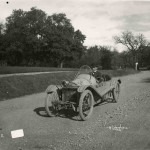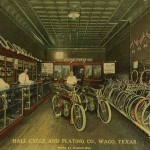Did you ever ask Santa for a pedal car? Was there ever a toy that seemed more simultaneously wonderful and out-of-reach? Maybe you wanted the fire truck with a bell you could ring, or the sporty car, or perhaps the airplane?
In the early days of automotive history, the irresistible desire to cruise and the immovable impediment of cost collided to bring in the era of the cyclecar. Cyclecars were lightweight vehicles, part motorcycle and part automobile. Compared to full-sized cars, they were inexpensive to purchase and operate, and were licensed and taxed at a reduced rate, further increasing their appeal.
The Hall Cycle & Plating Co. of Waco, Texas sold bicycles and motorcycles. Partners Lawrence Hall and John B. Fisher were active in the local Young Men’s Business League. (You can see one of their motorcycles with the Y.M.B.L. in the detail from a panoramic photograph below.) Then, in 1914, Lawrence Hall designed a chain-driven vehicle called the Hall Cyclecar. It had a four-cylinder, air-cooled 18 horsepower motor, seated two people in tandem, and could be converted into a light delivery van by removing the rear seat . Hall Cycle & Plating Company was reorganized into the Hall Cyclecar Manufacturing Co. and was incorporated with a capital stock of $25,000 by W. J. Lincoln, E.B. Baker, and Lawrence Hall. The 1914 edition of Automobile Topics reported that Hall hoped to sell the vehicle for $400. The prototype moved into production.
The cyclecar boom was brief. By the 1920s larger manufacturers began making affordable cars that undercut the cyclecar companies. In 1915, manufacture of the Hall Cyclecar stopped. Lawrence Hall moved to Los Angeles and a little bit of Texas history remained only in memory and photographs.
[slideshow]
Click on image to enlarge




